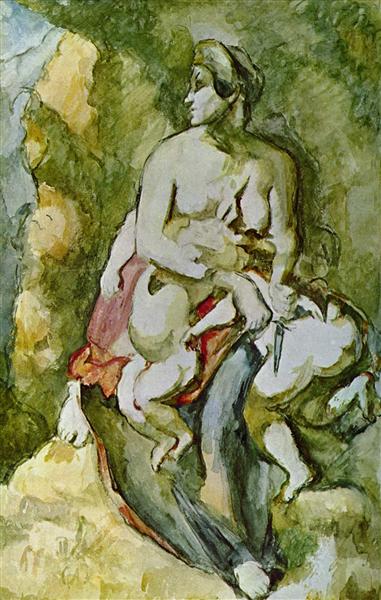विवरण
Paul Cézanne's Medea, painted in 1882, encapsulates one of the most intriguing strands of the French master's artistic development. Although not his most famous work, this painting is a testament to Cézanne's commitment to exploring color, form, and visual narrative in his quest to find a purer expression of reality. This piece sees the intersection where academic tradition meets what would eventually become Impressionism and Post-Impressionism, styles that Cézanne helped define.
Visually, Medea presents a composition that is both balanced and dynamic. The central figure of Medea, though stylized, conveys a deep sense of emotion and tragedy. The choice of a predominantly warm palette, with rich shades of yellow and ochre, contrasts with darker hues surrounding the figure. This use of color not only highlights Medea, but evokes the drama of the mythological narrative it depicts.
Medea's face, which is eerily serene yet intense, is a perfect example of Cézanne's mastery over the depiction of the human psyche. Her expression seems to capture a moment of deep reflection and determination, giving the painting an air of emotional tension. The figure is surrounded by abstract elements that, while depictions of everyday objects, become essential parts of the composition that support the visual narrative.
Cézanne's approach to light also deserves mention. Unlike the more "natural" methods of his contemporaries, the light in "Medea" seems to have an almost painterly quality, emitting from surfaces rather than simply being reflected. This gives the work a sense of depth and a dynamism that draws the viewer's eye into the centre of the canvas.
The narrative of Medea, a tragic figure from Greek mythology, is imbued with symbolic charge in the work. While the painting does not depict a specific moment in the Medea myth, the stylized figure suggests a mix of complex emotions: the rage, love, and despair that are part of her story. This narrative approach, combined with the abstract isolation of the figure, reveals Cézanne's ability to fuse form and content into a unique representation.
Throughout his career, Cézanne witnessed the narrowing of the gap between the real and the abstract, and Medea is situated in that transition. The work may not have the circulation that some of his other iconic creations, such as The Card Players or The Large Bathers, have, but its importance lies in how it reflects his evolution as an artist and his profound exploration of the human condition through art.
Ultimately, Medea is not only an example of Cézanne's talent for capturing emotional complexity and atmosphere, but also represents a significant stage in the journey towards a new perception of art. Its distinctive focus on the representation of form and colour, together with the narrative force it collects, gives it a special place in art history and in the lasting legacy of one of the great masters of Post-Impressionism.
KUADROS ©, a famous painting on your wall.
Hand-made oil painting reproductions, with the quality of professional artists and the distinctive seal of KUADROS ©.
Painting reproduction service with satisfaction guarantee. If you are not completely satisfied with the replica of your painting, we will refund 100% of your money.

